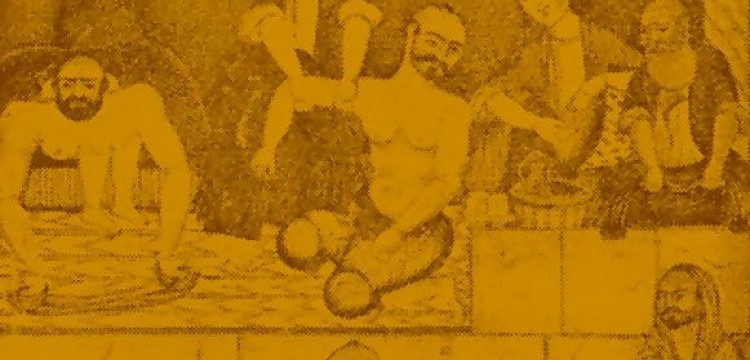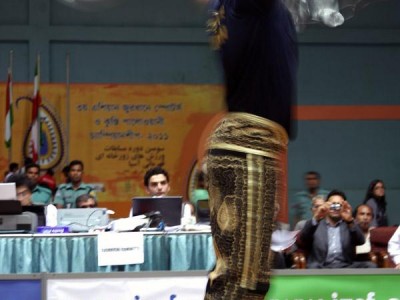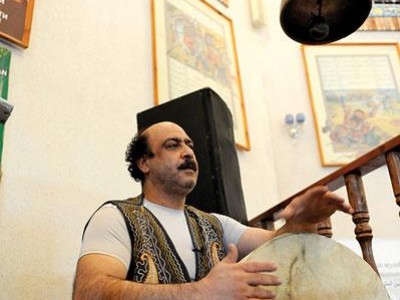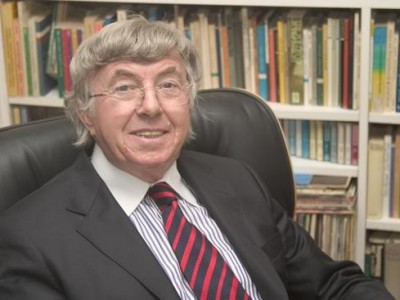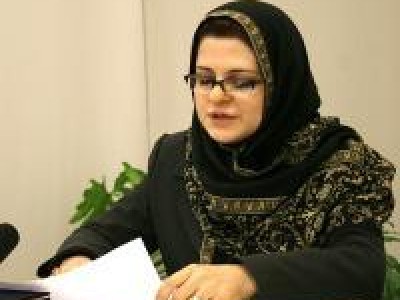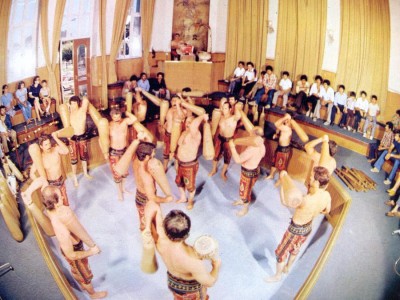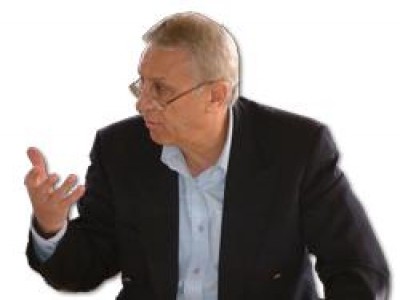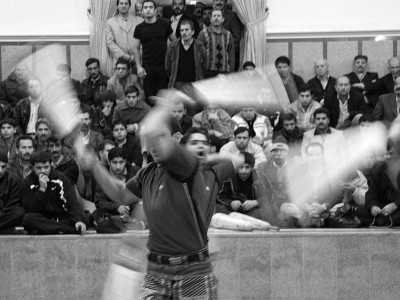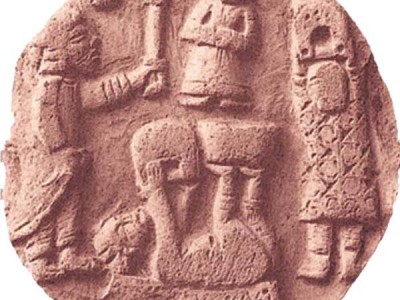| Syed Massoud Razavi A group of men in it to exercise and practice They play sports arts. In the available sources and histories, we don't know any history of sports or the presence of women in zorkhaneh, but in recent years, when the physical education of the Islamic Republic has given special support to ancient sports, the discussion about The presence of women in this sport and the allocation of some gymnasiums to women were also brought up and discussed and tested in a sports venue for several years. Zorkhanehs are generally located in traditional neighborhoods and in the back alleys of cities. It has a special traditional shape and its roof is dome-shaped and its floor is lower than the normal ground level. It has a short and relatively small door, which is often a bare one, and this door opens to a narrow corridor with a low ceiling, and that corridor is called "Sardam Zorkhane". leads to.
For this place, with these characteristics, moral justifications and a special philosophy are mentioned, and that is to bow in respect when entering and Whoever goes to this place for exercise, should keep his head down and put humility at the top of his work. But the structure of Zorkhane itself speaks to us and shows that, in addition to this, the moral views that have the signs of heroism and arrogance, have their roots in ancient times and in places far from the eyes. Like some abandoned warehouses, cellars, and water tanks, some social and militant groups have prepared themselves and engaged in combat training. This type of architectural structure is very useful in the dry and often hot weather of Iran, and limited groups of ten to fifteen people have been able to learn a set of physical exercises and martial arts in this space. The quality of sports, such as holding a pole, kabade and stone, is exactly equivalent to holding a sword and mace, holding a bow and carrying a shield, and it has helped the ancient warriors in this way. The quality of sports practices and traditions in such a place has been formed and cultivated gradually over many centuries. Sometimes there is a hexagon that is hollowed out about one meter depending on the location and is four to five meters wide. This part is called pit. Some researchers have written that they put several layers of bushes and weeds on the bottom of the pit and poured clay on it and leveled it. Bushes and khashak are poured to make the floor of the pit soft, and every day before the exercise begins, they moisten the surface with a little water so that dust does not rise. The entire wall of the pit is lined with saroj and its edge is covered with wood instead of brick, so that if the athletes hit the edge of the pit during exercise, they will not be injured. There are booths built above and around the pit where the spectators can sit and place the athletes' uniforms and tie their tunics. One or two of these stalls are also used for sports equipment, and we will give a brief explanation about them.
Therefore, the physical structure and architecture of Zorkhane definitely show many eras. It has been a long time since hand-to-hand battles were prevalent, and martial arts and martial arts were mainly horse riding, playing polo, shooting, and wrestling, which soldiers had to prepare for battle by practicing them. . Later, Zorkhane had a close relationship with Fatut and Sufism, and the young men, warriors and elders of Sufism had a closer relationship. Khanqah and zurkhaneh joined together and created a powerful spiritual, social and moral force. Iranians will return. Archeological excavations between Al-Nahrin and Lorestan region, related to 2500 to 2700 years BC, show people wrestling. According to the happy research of Professor Mehrdad Bahar, although there is no clear trace of Zorkhane in Iran in the pre-Islam era, but based on the similarities between the temples and the religion of Mehrdad or Mithraism with Zorkhane buildings and its rituals and Also, by referring to some of the writings of the authors of the early Islamic centuries that you did not seeIt can be said that there was probably a place for the cultivation of body and soul in the pre-Islam era.
As it appears from Ferdowsi's Shahnameh, at the beginning of the Sassanid period, young people were trained in wrestling in special places under the supervision of warriors, and in addition, in chapter 44 of Pahlavi wisdom, everyone is ordered to wear Bring confidence and self-confidence (i.e. wearing wrestling pants) and knowledge and take the shield of truth in hand and fight with what is the manifestation of the devil with the staff of gratitude and the bow of preparation. The analysis of the ancient legends of Pahlavi in Avesta, Ferdowsi's Shahnameh or texts such as Garshasb Nameh and the story of Samak Aiyar, shows the existence of many similarities with traditions and customs of Pahlavi.
What we know more accurately from the written chronicles is related to the seventh century, and the famous historian, Atta Malek Jovini (658 AH) in his history of Jahangashai, about the wrestling sport and the methods that today are interpreted as ancient sports. explained. According to Jovini's writings, one of the people who perhaps popularized and encouraged this sport was Oktai Qa'an, the son and successor of Genghis Khan. Jovini mentions two wrestlers from Hamedan who were cared for by Oktay, and the name of one of them was Pahlavan Fileh Hamdani. But the historical and mythological peak of wrestling and traditional sports should be sought in the 8th century. When a prominent warrior, writer and spiritualist named Mahmud Pahlawan and known as Puriya Vali appeared. This warrior, Mahmoud, is from Khwarazm and is called Qatali in poetry. His title is mentioned in various works: Puriya, Purba and Puriyar, and his death was mentioned in 722 AH. There were strong ayari and warrior tendencies among them, they started a rebellion. Wrestling and zurkhaneh sports were very popular among them, and it seems that during the time of the Mongols, when Iranians were forbidden to own and carry weapons and were prohibited from war, zurkhanehs were formed in cellars and abandoned and underground places. It was a perfect opportunity for unhappy men to strengthen their communication and physical fitness. In the 8th century, wrestling and wrestling competitions were very popular among the people, and archery competition was also common.
Iranian wrestling sport went to India in the 9th century of Hijri and At this time, the wrestler Yusuf Savi, based on the Bijarpur history, took the ancient sport and wrestling from Iran to India. For some time, he was the general of Sultan Muhammad Shah Bahmani, the king of Deccan, but in 897 AH, he ascended to the throne and received the title of Adil Shah, and he devoted himself to the promotion of Shiism in an important part of India. Various sources and numerous tazkira have mentioned the sport of wrestling and zorkhane in the 10th century, and it shows its widespread use during the Safavid period and after. During this period, the ancient sport reached the peak of its prosperity and its customs, equipment and rituals reached the perfection that we are still witnessing.
During the Safavid era The position of Pahlavan Bashi was one of the prominent and powerful officials next to the king. Pahlavan Bashi had a relationship with Qalandrans and Pahlavans of neighborhoods in Isfahan and big cities, and in a sense, they were responsible for security and maintaining some social and even economic affairs. Of course, the decline and decline of the Safavids in the last period of this dynasty, especially during the reign of Shah Sultan Hossein, caused the warriors to be considered as "bonded to wealth, honor and people's lives". reach out and be the cause of insecurity and the collapse of the dynasty. In most of the travelogues and reports of this era, we come across stories and anecdotes about this, but Mirza Hashim Asif's description in "Rostam al-Tawarikh" It is very expressive and has shocking details.
Historical texts and tazkeres, during the Afsharia and Zandiye periods, also narrated heroic stories. are These techniques and sports are still popular and the famous wrestlers of this period were Kabir Esfahani and Landre Doz Esfahani. and the formation of the Qajar dynasty, stability and peace came to the country. From the time of Fath Ali Shah Qajar, we have not only reports of Zorkhaneh, wrestling and wrestling, but also pictures of these sports and places. A matter that reached its peak during the era of Naseruddin Shah.
During this period, in Tehran's Citadel Square, in the presence of the Shah and prominent men and a large number of people and even travelingO foreigner, wrestlers, wrestlers, and ancient workers were engaged in testing and performing sports arts. Shah was interested in this issue and supported the athletes. The court had a powerhouse and wrestlers who were preparing for the important wrestling ceremony and the appointment of a wrestler. With the approval of the Shah, their own apparatus established some powerhouses and gathered some wrestlers and athletes around them and paid their salaries. The greatest wrestlers of this period, one is the wrestler Ibrahim Yazdi, known as the great Yazdi, and the other is the wrestler Akbar Khorasani, who was the last official wrestler of Tehran during the Qajar period. At the same time, photography was found and numerous photos of wrestlers and wrestlers and sports and wrestling events were recorded. These pictures show that Zurkhaneh and Pahlavi sports continued in almost the same way as we know them during the Nasrid period. The only difference was that other nobles and courtiers did not independently establish a coercion and did not provide support except when using some coercives. In the 1330s, the entry of some powerhouse athletes such as Shaban Jafari into the political arena and the coup d'état against the national government of Dr. Mossadegh gave new life to several sports halls and powerhouses in Tehran, and the court and some country and military officials supported it. they paid. In this era, wrestling sport with new international rules also became popular, many of them came out of traditional wrestling and zorkhanehs. Finding small and independent zurkhanehs, along with several zurkhanehs. Famous in Tehran and big cities, it was a support for wrestling. Soon wrestling became the first and national sport of Iran and introduced great heroes to the society. Through wrestling, "concept of heroism" Along with "pahlavi" It was found and the heroes were the medalists who won in the national and international competition and created pride. The biggest and most popular heroes were, of course, those who had heroic qualities. At the same time, an outstanding athlete emerged in the fields of powerlifting and wrestling mats, who became Talipuria Wali in both championship sports and wrestling, and his name became the epitome and symbol of wrestling and wrestling in the new era. He was Gholamreza Takhti, who was called "Jehan Pahlavan" by the people. has been honored Unlike Shaaban, Takhti spared no efforts in supporting the fallen and deprived people, and at the same time, he was a political opponent against the royal government after the coup and had a close and friendly relationship with the members of the National Resistance Movement and the National Front. .
Zorkhane literature and art
In Zorkhane, poetry and music It is used and it is basically one of the influential pillars of ancient wrestling sports. A verse of Hakim Ferdowsi's poem and the names of Shahnameh warriors are always repeated in the description of mentors and athletes and ornaments on the door and wall of Zorkhane: ; Zayed's crooked weakness and shortcoming
All over Shahnameh is the arena of heroic arts and ethics. Rostam, Sohrab, Esfandiar, Siavash, Arash, Giv, and Guders are the best fighters and are symbols and proverbs in wrestling, shooting, fighting, and riding.
Especially Rostam, who is a legend and a symbol of supreme strength, courage, worship of Yazdan and friendship with Iran. According to Hakim Ferdowsi, they were the breeders of brave sports and war: Don't be afraid of what will happen to the campaign. Be bold, the aggressive man of the atmosphere
Afraid of the young swordsman Be careful of old people who are very technical
The poems that are considered by the fighters, of course, in the context of struggle and war, mainly have an epic tone and chanting, but the spread of the spirit of Fatut and Sufism has caused So that some kind of politeness and didactic poetry become common among them, a part of which is common among the people, like the likes of Saera. Murshid Zorkhane has always had an educational and profound effect on athletes and the atmosphere of Zorkhane by reciting epic poems, which were sung with a charming voice and accompanied by rhythmic music. These type of poems mainly have a specific rhythm and weight and are often written in the same tone as the Shahnameh. Hey, to the percussion song, "Gol Geshti" and "wheel flower" It is called and it includes the types of "right to read", "requesting leave". and "the prayer for the end of sports" It is also there and it is read according to the time and situation. In addition to the poems of the Shahnameh, some poems attributed to Puriya Vali are also recited by the gurus. In the tazkira, in addition to the title of a warrior, a poet from Puria Vali is also mentioned and these three quatrains are dedicated to this pious man:I removed from the place and place The voice of the world is happy with a bite
They are turning our government's turn on the wheel. That ant should be milked from our soul
And the last quatrain is that it is one of the examples of general culture and one of the famous examples of heroic culture and fatwat literature:
- If you die on your own soul, Amiri If you don't criticize someone else, you are a man. Gardest Fatadeh, get a man. The terms Zorkhaneh, wrestling, and wrestling have always been effective among the poets of different ages and were not only exclusive to the Shahnameh and the epics. Is. Sometimes love poems, ghazals and odes have also been influenced by this culture. Especially during the Safavid era, when the Indian school of occurrence and style became popular. For example, Miranjat Esfahani, one of the poets of the Safavid era, wrote the terms and techniques of wrestling in a Masnavi, which is suitable for reading by teachers. sometimes in another way, including in this poem where the term "hand down" It was used in an official sense among the wrestlers in the pit, and when they wanted to fight with the opponent, they touched his sign:
If a subordinate stands up with me, his back is on the ground, and this verse The term "on hand" One of the wrestling techniques used!
- it is possible to put the back of the hand before the subordinates
on the hand It is difficult to eat from one's subordinates
Among the poems of Zorkhaneh, there are poems in praise of Amirul Momineen Ali (a.s.) who is the only warrior and chivalry and the leader of the warrior and fatut in culture. It is Islamic, it has a special place. Sometimes special poems were written especially for Pahlavi, and sometimes epic works like "Khavaran Namah" The work of Bazel Mashhadhi, due to its fit, was the language of the gurus.
The music of Zorkhane has also evolved and over the centuries it has become a deep-rooted style and tradition. . The important issue in this context is the permanence and continuity of the said music. Zorkhaneh music has four basic elements. 1- Murshid, 2- Zarb Zorkhane, 3- Zorkhane bell and 4- Poems that are recited. Professor Mohammad Reza Darvishi in the second volume of "Encyclopedia of Instruments" Iran, p. 376 (Mahor Publications, 2014) writes: "Tanbek Zorkhane is an important element of Zorkhane sports ceremony or ancient sport and it is the largest one-sided sound skin (open side) in Iran in terms of size, which is played by hand." span>.»
The Zorkhane bell is also a metal hemisphere that hangs above the master's head, and when playing, the master takes the metal ball inside the hemisphere and hits the body. hit The bell has multiple functions; including greeting Zorkhaneh and starting the movements, changing the rhythm and moving from one exercise to another. And finally, to respect the elders present, either enter or take a great name from among the warriors. Zarb and Zang is played by Murshid, who is the spiritual leader of Zorkhana, and he himself has a history of bravery and valor and is famous for his goodness. With complete knowledge of the people, movements, space, poems and music of Zorkhane, he takes care of leading rhythmic and athletic movements, training new recruits and other issues. One of the contemporary researchers has written: "Since the end of the Safavid era, when the principles of Sufism and mysticism were spread in Zorkhanehs, the old riders of Zorkhaneh were gradually recognized as teachers, and then, over time, they were also responsible for playing the Zorkhaneh's tinbak". became In other words, the "murshid" or "old man" riding the bullpen and the tanbak player became a single person. > In the music of Zorkhane, "convergence and homogeneity of apparently opposite elements with the content of the words" is formed in the performance of Murshid. The praise and praise of Zat Ahadit and the praise of Muhammad Mustafa (pbuh) and Hazrat Ali (pbuh) which is often the beginning of the words and songs of the mentor, as well as poems from the Shahnameh that show the bravery and bravery of Iranian mythological heroes, as well as the performance of poems Sufi mystics and poets such as Maulana Jalal al-Din and Hafez, and Saadi's admonition and admonition poems, all of them are recited along with the music of Zorkhane. It is said that this apparently disparate group is indicative of the hidden and open aspects of the Fatut and Aiyari religion and Iranian heroism; The characteristics that have been formed over the centuries in the transition from the historical ups and downs of Iran and distinguished from the dominant culture of the era in each era and at the same time have expressed part of the cultural essence of that era throughout history. It is enough to follow the ups and downs of compiling fatwat from the first centuries of Hijri to the era of Caliph Al-Nasir al-Din Allah in the seventh century and then to the Safavid era and then to the present era to see the role of the social, political and cultural conditions of each era in Let's find out this evolution/span. know to some extent Especially parts of Humayun's, Shur's, Shushtri's, Dashti's, and Bayat Turk's systems, but of course the difference between Murshid's recitation and traditional recitations should also be taken into account. Murshid's song often lacks common and especially modern writings in the way of performing instrumental music. This difference in tone and technique makes Murshid's singing look more authentic. The mastery of proper reading and proper playing, benefiting from a wide repertoire of poetry and words, and skill in performing Zorkhaneh vocal techniques, while possessing the ability to lead the movements of athletes, differentiates the leading mentors from others. The part is used from Mr. Mohsen Shahranazdar's article, entitled "Zorkhaneh Music", published in "Wayt and Sport" magazine, Spring and Summer 2018.)
Ancient sports tools and terms
The special terms and vocabulary of Zorkhaneh and traditional sports are truly a separate and independent culture and encyclopedia. Some of its terms and words, of course, are rarely used today and are even obsolete. For example, terms that were formed during the decline of Pahlavi and chivalry in the late Qajar and Pahlavi eras, under the title Dash Manshaneh and Jahili subcultures, and entered the Zorkhanehs. However, it is still possible to count and collect many special words of Zorkhaneh and Pahlavi in Iran, and this shows the cultural and social richness of this phenomenon in our history. Here we explain some important terms and express a number of specific terms. This place and its history and relations are special:
- Murshid: As it was said, today a Murshid is someone who sings in a certain way in Zorkhaneh, when Sports, on "cold" He sits and directs sports movements and manners with the beat and bell song. In the old days, "Murshid" or "old rider" He was the one who trained athletes and wrestlers with him. The old rider used to carry a limp during exercise and a stick that he called "educational". It was said that he would hold it in his hand and sit by the pit and guide the ancients or wrestlers in sports and wrestling. Veteran riders or mentors were among the most agile and experienced wrestlers and athletes. It seems that today, the teacher is called a ``beater''. They are also called.
- Pre-face: In Zurkhane, they call someone who is older and more experienced than other athletes. Pre-Ksut is aware of all kinds of ancient sports and their details and can perform ancient sports better and heavier than others.
- Miandar: He is an athlete in the pit, he stands in front of the mentor and in the middle of the other athletes, and he is in charge of turning the sports and throwing the sports activities back and forth. Athletes look at him during sports and follow his movements and methods. Midandar should be experienced and aware of all the subtleties of the ancient sport, just like his predecessor. Usually, the front man of every powerhouse is the Miandar there, but sometimes due to old age or absenteeism, other men or some talented and agile youths also become the Midandar.
-Pahlevan: It is said to the wrestling heroes who are experienced in ancient techniques and martial arts as well. Usually, a wrestler should be very experienced, agile and experienced and not be complacent in physical exertion and sports exercises. In some neighborhoods, sometimes two or more wrestlers meet or are found close to each other, and this is because sometimes one wins and sometimes the other wins and receives a wrestler's armband, but the title of a wrestler does not fall from them. Be.
- Nokhashte: A young man who has gained experience and broadened his range of sports activities and is ready for wrestling and sports. He goes to other gymnasiums.
- Nocheh: It is said that a young athlete learns wrestling and ancient sports techniques under the supervision of Pahlavi. He is considered his student. In terms of dexterity and agility, he is the most chosen of that wrestler's students, and is usually his companion behind the wrestler's head. Sardam: in the custom of wrestlers. It is considered a sacred place, and keeping it lit, like keeping the taverns lit, has been a necessary task, and therefore, the "cold lamp" It should always be on. This place, Sardam, has a platform installed in one of the pavilions which is the entrance to Zorkhane, and the master of Zorkhane sits there. A circular or square platform with a height of one meter and sometimes a little higher, in front of the cold and towards the pit, they make a wooden platform for Hanging bells and installing swan feathers (known as ablaq) which in the old army were installed on their helmets instead of ranks, as well as other manifestations of valor and bravery such as leopard skins, armor, swords and shields. In front of the cold room, there is a stove that is used to heat zab and also The special boiling ginger and cinnamon coffee, which is given to athletes after exercise, is placed next to the stove fire. Eating brewed or cooked ginger and cinnamon after exercising in Zorkhaneh, in addition to changing the taste, is said to remove dampness. Usually, in order to keep the Sardam lamp lit, they ask for money from the attendees and the people, which they gradually call it "light money" and the itinerant wrestlers rotate a bowl or a hat when asking for money. They say turn on the first light or our tonight's light.
- Mesht and Malchi: He is the one who gives the wrestlers limps and tankas before sports and then From exercise, he gives them punches and massages (or massages) so that bruises and fatigue go away from their bodies. The cleaning and services of Zorkhane have also been done with fists and mulch. It has been designed and formed for a type of ancient sport specific to this sport. There are different types of desire. Among them:
1- Game mill, which is made of a kind of white and small wood, is used for games and sweets. The handle is made as high as possible so that it can be easily turned, thrown and released during the game. Games that are played at will do not have certain rules and regulations. Every athlete plays all kinds of games with his taste and taste, and what has been observed is that the players like to play more than 30 types of games, and this is one of the sweetest acts of ancient sports. br /> 2- Big rods are rods that are used for ancient sports and do not have a specific weight. The weight of most of them is 12 to 30 kilos per pair, and some experienced and veterans can use them. 3- Normal desire, The main mils are in wrestling and their weight is not more than five to 6 kilos.
In the past, it was usual that first, the one who had the lineage of the ruler, first the mils. He would raise himself to the beat of the master and after a few short movements, he would put the wishes on his shoulder, and after this act, you would start from the most senior person and end with the beginners until all the wishes They lifted them up and put them on their shoulders. Nowadays, in order to avoid wasting time, all athletes lift the arms and put them on their shoulders. There is no specific count for taking or taking a meal. Rather, the master of Zorkhane keeps the athletes busy by playing songs and reciting poems, and as soon as he brought the wishes from his shoulder to the ground, the others followed him and placed the wishes in a special place. They put themselves.
4- Gorgeh, this term has been used in recent years, especially in the brothels of Tehran, if taking Gorgeh, It is a type of grip where the athlete accelerates his movements to the maximum speed and grabs the wrists, so to speak, and the mentor plays a special song for this movement, and that song has been called Gurge since ancient times, and the word Gurge comes from It is a Mongolian word that has remained in Persian, and originally it was the name of a kind of drum or drum that was played in wars in the past.
- Swimming board: It is smooth wood, 70 cm long, 7 cm wide and 2 or 3 cm in diameter, which is sometimes made a little smaller or larger than these dimensions. Under the swimming board, near its two ends, two four-centimeter-high trapezoidal legs are installed so that it stays firmly on the ground during use. There are many types of swimming on the board, from normal swimming to breast press and twist swimming.
- Stone: two pieces of stone are split and right corner. which is installed to each other with metal fasteners and one side is a crescent. The length of the stones is one meter and the width of each one is seventy centimeters. In the middle of the stone, there is a hole in which a handle is placed and covered with felt or cloth so that the athlete's hand does not get hurt when picking up the stone. The weight of both stones varies from twenty kilos to one hundred and twenty kilos and depends on the power of the stoner. In the past, the stone was called "Zor stone". and "Sang Nali" It is also called because it resembles a horseshoe. Embedded. Its length is about one hundred and twenty centimeters. Chele Kabade is a chain with sixteen rings, sometimes less or more, and each ring has six iron flakes, and a jadsti is placed between them. The weight of the liver varies from ten to forty kilos, but sometimes for strong people, heavier livers are also used. : It is a short pant that covers the thigh to below the knee and is worn during sports and wrestling. This turban is made of a leather top with a setbar mahout fabric and several layers of canvas lining. Its top is mostly blue-green in color. The back, seat and head of the two-legged tank are made of leather. On the trunks, large flowers and bushes are designed in the style of slim designs in carpets. bEla called the tank "tower", the front of the tank that falls under the stomach "before the bill", on the knee "before the bowl". or "Serkaseh" and the back of the knee "back" bowl" It is called a mi-mand.
- Lang: It is the same cloth that men wear in the bathroom. Sometimes, instead of a tankard (which is very expensive and rare in our era), some wear a limp and go to the pit. The method of tying the leg is to tie two ends of the length of the leg in the waist area on the navel and take the bottom of the leg that is hanging from the back of the leg and lift it up between the two legs and in the "front" bill» which is the same knot, they sink and make it strong. The most experienced and the oldest athlete, who has the title of veteran, becomes the middleman and the middleman. Gud stands in front of Murshid. An athlete who is older and more experienced than the other athletes after him, stands on my feet, and if there is Sidi among the athletes - whether old or new - he also stands on my feet, and if He had the merit of being a mediator, he has gone to the middle and is a mediator. In this case, the main veteran stands facing him - cold feet - or behind him. An athlete who is more untested and immature than others is called a novice and his place is behind the pit, behind the head of the middleman. Others stand around in order of experience and background and age. We give the rest of the terms without explanation, and these are perhaps not less than a third of these terms: Golrizan, Shirin Kar, Pir, Pahlavan Sahib Taj, Tashe Kar, Nokhashte, Bakhsh, Wardi, Bang, Bang Khalil Elahi, &zwnj ;bone cracking, Saying by God, Heading this way and that, wrestler's armband, throwing over the pit, rock pillow, badalght, fatut band, kissing, twisting together, flat skin, force, confetti, pre-bill, the crown of poverty, dancing, Ignorant, jirga, Searching for crows, mating, umbrellas, dash, dav, dakhl, Dost Merizad, taking a breath, far, friend, asking for permission, Rashmeh, coming up, Rudast, Zawiya, Zang Heydari, becoming deaf, Sarute Mehr, Safai step, hose board, safeh, to draw the lame, qadarhak, kesti, stretch, loti, Naloti, limping, suitable reading, nata, haram, badaft etc... Peace be upon you and Allah's mercy and blessings.
Resources
1- History and culture of Zorkhane and social groups of Zorkhane, Ro, Gholamreza Insafpour, Akhtaran publication 1386. // 2- The heritage of Pahlavani, Ebrahim Mokhtari and Hoda Saber, Research Vice President of the Institute of Anthropology - Cultural Heritage Organization 1381. // 3- Revival and renovation of Zorkhane, public relations of Tehran City Beautification Organization. // 4- From myth to history, Mehrdad Bahar, compiler and editor: Abulqasem Ismailpour, Cheshme publication 1377. // 5- Symbols in Zorkhane clothing, Farideh Majidi Khamene, article included in the journal: Cultural Heritage Research Institute Letter, number 7, summer 2013. // 6- Zorkhaneh - Spiritual Heritage, Cultural Heritage News Agency, Internet www.chn.ir, dated 13/11/2018. // 7- Zorkhaneh, Aftab, Internet aftab.ir, 9/11/1389. // 8- Dictionary of wrestling terms and ancient sports, Farhang Mendor magazine, numbers 17, 18 and 19, October and November, Azar and Bahman 1349. // 9- Zorkhaneh and ancient sports, Farya online magazine, www.farya.com, on February 2, 2019. // 10- Fatutnameh Soltani, Molhasin Waez Kashifi Sabzevari, proofreading and introduction by Dr. Mohammad Jaafar Mahjoub, Farhang Iran Foundation 1350. // 11- Encyclopaedia of Iranian Instruments, Mohammad Reza Darvishi, Mahur 1384. // 12- Tanbak and attitude to rhythm from different angles, Bahman Rajabi, Tehran 1356. // 13- Varieties of Persian poetry, Dr. Mansour Rostgar Fasaei, Navid Shiraz Publications 1372. // 14- Karvan Hind, professor Ahmed Golchin Maani, Astan Quds Razavi Publications, 1378. |

